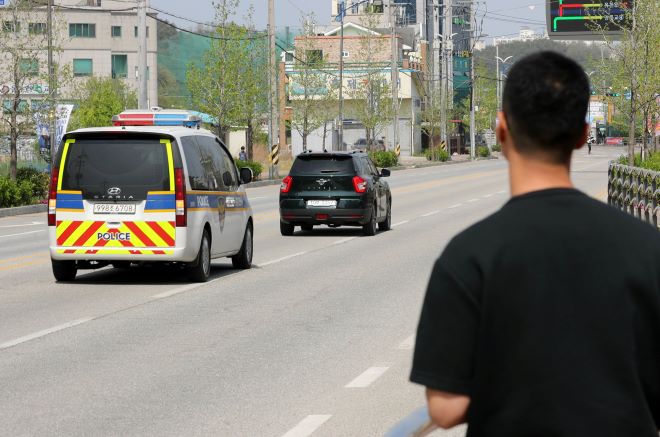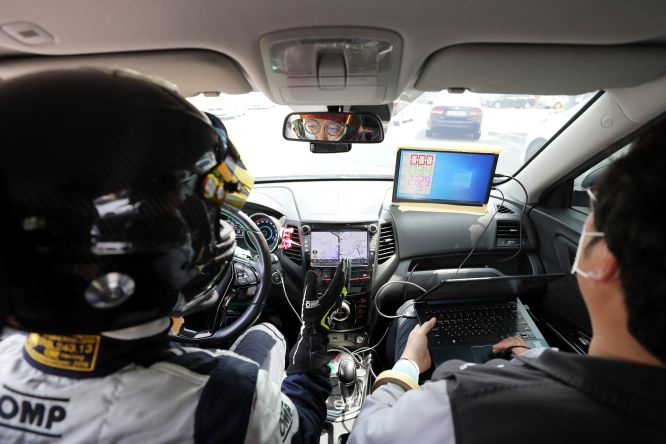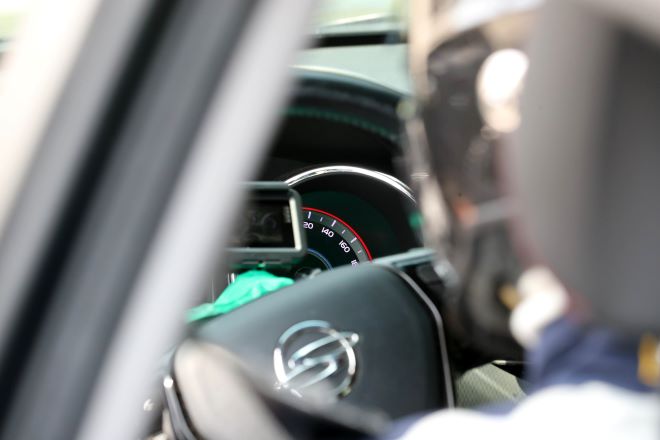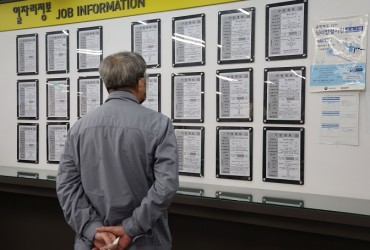
The “reenactment test” that will reveal whether the vehicle’s defect caused the sudden acceleration took place on the afternoon of April 19 at Hoesan-ro in Gangneung City. Lee Sang-hoon, the father of Lee Do-hyun, who lost his life in the sudden unintended acceleration accident, watches the reenactment test. (Image courtesy of Yonhap)
SEOUL & GANGEUNG, Apr. 20 (Korea Bizwire) –In an unprecedented move to determine the cause of a tragic 2022 vehicle acceleration incident that claimed the life of 12-year-old Lee Do-hyun, South Korean authorities conducted an on-site “reenactment test” on April 19, the first of its kind in the nation’s history.
The two-hour test in Gangneung, utilizing a 2018 Ssangyong Tivoli Air matching the model year involved in the fatal crash, yielded results that appear to undermine the theory of pedal misapplication by the driver, identified only as Mr. A, who was Dohyun’s grandfather.
The reenactment was part of a damages lawsuit worth approximately 760 million won filed by Mr. A’s family against automaker KG Mobility. They seek to ascertain whether a vehicle defect caused the unintended acceleration that led to the collision claiming young Do-hyun’s life.
Under police supervision and observation by a court-appointed expert, diagnostic equipment provided by KG Mobility was connected to the test vehicle during four separate trials replicating key moments from the December 2022 incident.
In the first trial, replicating the initial “whooshing” sound from the engine before rapid acceleration and collision with a Kia Morning hatchback, the vehicle reached speeds of up to 120 km/h with full throttle application.
This exceeds the increase from 110 km/h to just 116 km/h recorded by the event data recorder (EDR) in the final five seconds before impact, prompting plaintiff assertions that the EDR’s full throttle recording itself was flawed.
“If maximum acceleration had continued, our claim of reaching 140 km/h would have been validated,” stated Ha Jong-seon, the attorney representing Mr. A’s family.
Subsequent trials simulated the moments before the collision with the other vehicle by flooring the accelerator from 40 km/h for 2-3 seconds, resulting in speeds up to 80 km/h – significantly higher than the 48 km/h projected in the National Forensic Service’s analysis.
Another test from 60 km/h replicated the 5 seconds after impact, with speeds reaching around 100 km/h under full throttle.
“The speeds observed differ greatly from the National Forensic Service’s velocity and RPM graphs, exceeding their analyzed speeds. This suggests their conclusion of pedal misapplication by the driver was incorrect,” Ha stated.
In the final test replicating the EDR’s recording of full throttle from 110 km/h for five seconds before impact, the vehicle reached 135-140 km/h – closer to the 136.5 km/h estimate by the court expert but markedly higher than the forensic service’s 116 km/h calculation.

In Gangneung, Gangwon Province, a ‘reenactment test’ to determine whether a defect in the vehicle caused the sudden unintended acceleration of a car that killed Lee Do-hyun (12 years old at the time of his death) in December 2022 was held on the afternoon of April 19 at Hoesan-ro in Gangneung City. Cameras and transmission diagnostics are being installed on the 2018 Tivoli Air, the same model as the accident vehicle. (Image courtesy of Yonhap)
“This first-ever reenactment test for a suspected sudden acceleration incident in South Korea strongly suggests that pedal misapplication by the driver did not occur,” Ha emphasized after the trials. “While awaiting detailed analysis, our assertions throughout the trial have gained significant credibility.”
The plaintiffs legal team argues the test results scientifically demonstrate the absence of pedal misapplication, strengthening their claim that a vehicle defect caused the unintended acceleration.
“Anyone who has driven this road would know it’s impossible for pedal misapplication to occur,” said Lee Sang-hoon, Mr. A’s son and Do-hyun’s father. He expressed frustration that consumers must go to such lengths to prove non-defect product liability, revealing this marked 501 days since Do-hyun’s passing.
Lee urged the outgoing 21st National Assembly to pass the “Do-hyun Act” amending product liability laws before its imminent expiration, vowing to refile the petition in the next parliament if necessary. Despite over 50,000 signatures supporting discussions on the act last year after the family’s petition, it stalled due to the previous parliament’s term ending.
The legal battle continues on May 14 when the damages case resumes at the Chuncheon District Court’s Gangneung branch.

In Gangneung, Gangwon Province, a ‘reenactment test’ to determine whether a defect in the vehicle caused the sudden unintended acceleration of a car that killed Lee Do-hyun (12 years old at the time of his death) in December 2022 was held on the afternoon of April 19 at Hoesan-ro in Gangneung City. Cameras and transmission diagnostics are being installed on the 2018 Tivoli Air, the same model as the accident vehicle. (Image courtesy of Yonhap)
M. H. Lee (mhlee@koreabizwire.com)






